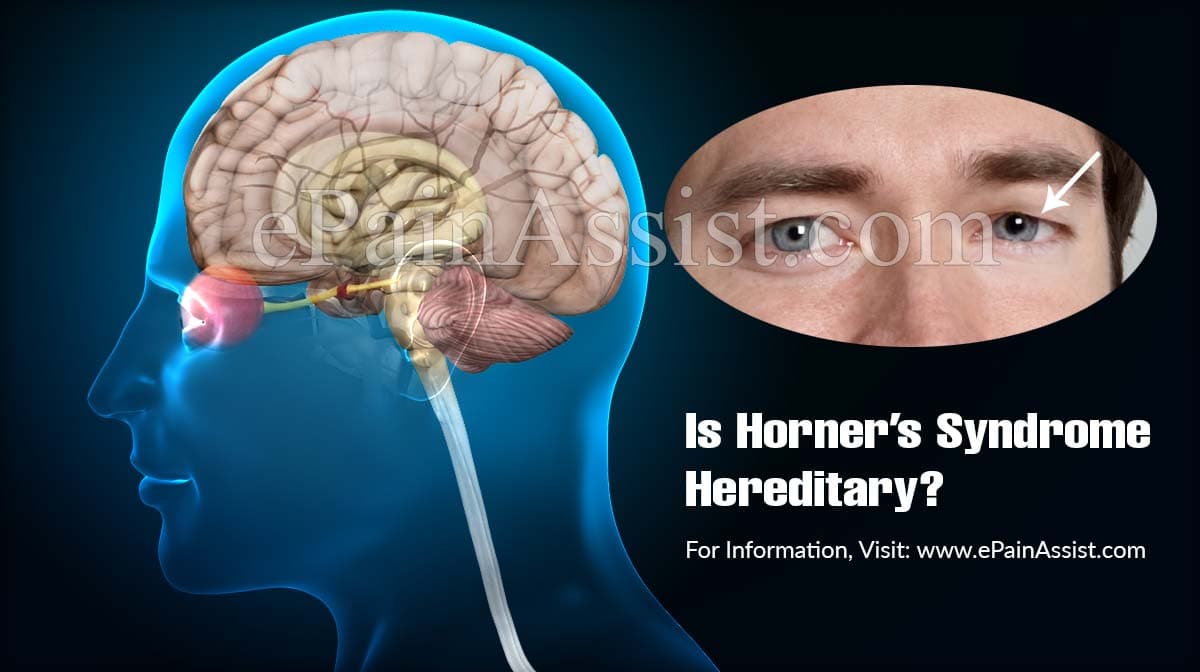Horner syndrome is a mixture of symptoms that are caused when there is an interruption of the nerve pathways that go from the brain to the face. The most common signs or symptoms can be seen in the eye. It is a fairly rare condition. Horner syndrome can affect people of all ages.(1)

Is Horner’s Syndrome Hereditary?
Horner syndrome is not inherited and occurs in individuals without a family history. Acquired Horner syndrome and most cases of the congenital Horner syndrome have non- hereditary causes.
Horner syndrome may exist at birth (congenital) or acquired in the course of life. In congenital cases, the disease is usually caused by childbirth trauma.(2) The symptoms of Horner syndrome usually affect only one side of your face. You may experience a variety of symptoms, including the following:
- The pupil of one eye is much smaller than that of the other eye, and it will remain smaller.
- The eye pupil that has symptoms does not expand or expand very slowly in a darkened room. It can be difficult for you to see in the dark.
- Your upper eyelid may sag. This is called ptosis.
- Your lower eyelid may appear slightly raised.
- You may not have enough sweat on one side or in an area of the face. This is called anhidrosis.
- Infants may have a lighter iris in the affected eye.
- Children may not have any redness on the affected half of the face.(3)
How Does Lung Cancer Cause Horner’s Syndrome?
Horner’s syndrome is characteristic of certain pathologies.
Horner’s syndrome results in a set of symptoms: ptosis (fall of the upper eyelid), miosis (retraction of the pupil), enophthalmia (retraction of the eyeball which seems to be sunken in the orbit) and absence of sweating. It can also result in severe pain in the shoulder and arm. This syndrome is due to damage to the nervous system which can be caused by a stroke, but also by lung cancer in the upper lobes.
Horner’s syndrome is one of the symptoms of lung cancer. Indeed, when we observe the sympathetic disorders typical of this syndrome, the doctor can suspect the presence of lung cancer on the same side. However, lung cancer causes few symptoms and it is usually only at an extremely advanced stage (stage IV) that the diagnosis is finally made. Other non-specific symptoms can sometimes be observed: cough and chronic bronchitis, abnormal shortness of breath or bloody sputum. Chest pain is sometimes felt, but it is not enough to diagnose lung cancer.(4)(5)
How Is Horner’s Syndrome Diagnosed?
Horner syndrome is diagnosed in stages. It starts with a physical exam by your doctor. Your doctor will also look at your symptoms. If Horner syndrome is suspected, your doctor will refer you to an ophthalmologist.(6)
Treatment Of Horner’s Syndrome
There is no specific treatment for Horner syndrome. Instead, the condition that caused the Horner syndrome is treated. In some cases, if the symptoms are mild, no treatment is required.(6)
Horner syndrome causes considerable eye complaints, which can extremely affect the life of the person concerned. In most cases, the pupils are greatly enlarged and the eyeball is retracted. The upper eyelids can also hang down and thus negatively influence the aesthetics of the patient. Cosmetic complaints often lead to inferiority complexes or reduced self-esteem.
It is not uncommon for patients to be ashamed of the symptoms. In serious cases, it can also lead to a visual disorder or other visual impairments. These generally have a negative impact on the everyday life of the person concerned and also reduce the quality of life. In most cases, there is no direct treatment for Horner syndrome and its symptoms.
Instead, the underlying disease is always examined and treated, and there are no special complications. The complaints usually disappear when the underlying disease has also been overcome. Horner syndrome does not change or reduce life expectancy. In most cases, the disease does not go away on its own, so the symptoms increase without treatment.(7)
- Nasser BA, Mesned A, Moazamy YE, Kabbani MS. Horner’s syndrome after paediatric cardiac surgery: case report and review of the literature. Cardiology in the Young. 2015;25(3):569-572.
- Khan Z, Bollu PC. Horner syndrome. StatPearls [Internet]: StatPearls Publishing; 2019.
- Smit DP. Pharmacological testing in Horner’s syndrome–a new paradigm. South African Medical Journal. 2010;100(11):738-740.
- Sayan M, Çelik A. The development of Horner syndrome following a stabbing. Case reports in medicine. 2014;2014.
- Lueangarun S, Auewarakul CU. Diffuse large B cell lymphoma presenting as Horner’s syndrome in a patient diagnosed with neurofibromatosis type 1: a case report and review of the literature. Journal of medical case reports. 2012;6(1):8.
- Davagnanam I, Fraser C, Miszkiel K, Daniel C, Plant G. Adult Horner’s syndrome: a combined clinical, pharmacological, and imaging algorithm. Eye. 2013;27(3):291-298.
- Flores S, Riguzzi C, Herring AA, Nagdev A. Horner’s syndrome after superficial cervical plexus block. Western Journal of Emergency Medicine. 2015;16(3):428.
